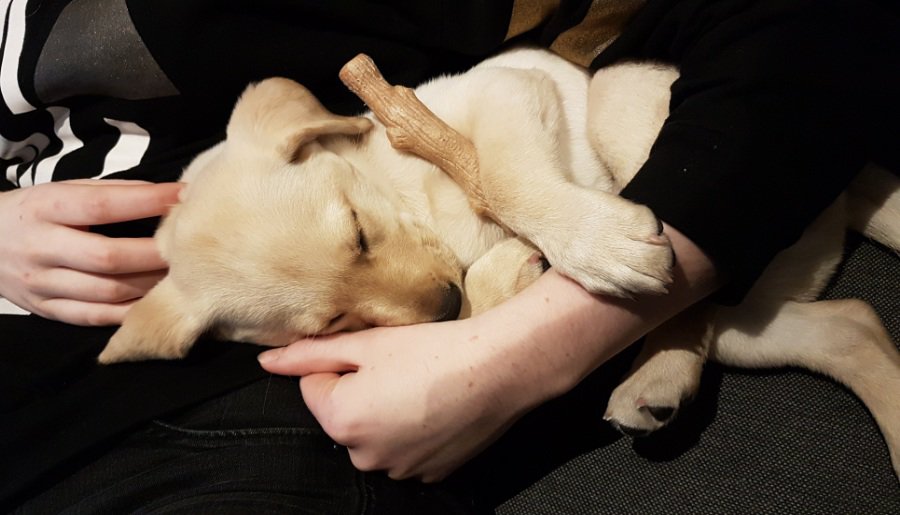
When it comes to dog training, there are many people out there who have the wrong idea. I’m talking about those who try to control their animal’s behavior through fear alone. Contrary to popular belief, this kind of thing is not natural for a canine.
In a pack of wild dogs, the pack leader doesn’t simply rule by fear and intimidation. Rather, they rule by creating loyalty. The pack leader provides for the pack and takes the lead in protecting it from danger. Loyalty, not fear, is the bond that holds a pack together. With this idea in mind, I want to give you a few ideas about how to create the kind of loyalty that will hold your pack together through thick and thin.
1. Get an early start
This item is the first one on our list because it is probably the most important. When you are trying to create a strong bond between dog and human, it is essential to start when the dog is still very young.
Nature has made the task easier here, as it is much easier to bond with a puppy than it is to bond with a full-grown dog. At this point in their life, they are pretty much lost without a parental-type figure to guide them. By making sure that they see you as their parent, you ensure that the dog will have a deep sense of loyalty and gratitude towards you.
I cannot emphasize enough that there is a need to spend as much time as possible with your puppy. Whether you’re taking care of their needs, playing with them, or just letting them sit in your lap, every minute that you and your puppy spend together will serve to increase the bond between you.
It should be noted that it is possible to create a strong bond with an animal that you did not raise. In fact, some of the best dogs I’ve ever had were rescued dogs that came to me as adults. A dog that has been abused by others will often appreciate kindness to a greater extent. When dealing with a dog that you didn’t raise, it is important to establish a bond right away, just as you would do with a pup.
2. Set a designated amount of bonding time
In the wild, a pack of dogs does everything together. They are together pretty much from the moment they wake up until the minute they go to sleep. This closeness that exists between pack members is a good survival tactic, as it maximizes their ability to hunt and move as a single unit.
Unlike you or me, the members of a dog pack do not have to leave their family to go to work or school. Their education comes only from one another, and their only job is to provide for one another.
With this reality in mind, you should try to spend as much time with your dog as possible. With all the never-ending demands of life, this can be a hard thing to do. However, if you want a dedicated pet, you must be willing to invest your time. As with anything in life, your results will depend greatly upon the amount of effort that you put into the endeavor.
One way that you can make things easier is by multi-tasking. Obviously, most of us are not able to take our dogs to work or school. Even if we could, we would likely be too busy to pay attention to them. So, try instead to integrate your bonding time into normal household activities.
For instance, when you are trying to do some cleaning around the house, you can encourage your dog to follow you around with a treat or two. As you are working, stop every once in a while to pet your dog and tell them how good they are. Since they don’t really understand what you’re doing, any involvement on their part will make it seem like a pack activity.
3. Put yourself in the mindset of a dog
In order to bond with your dog, you have to consider your mindset as well as that of your dog. It is a general rule that, if you understand a particular creature, it becomes much easier to get along with them.
The better you can understand the mindset of a dog, the better you can understand what your dog needs and wants from you. You can also better understand how to make your dog understand what is expected of them.
Many people tend to think of dogs as being dumb. After all, they do all kinds of dumb, knuckleheaded things. They certainly aren’t capable of the things that we are, but that doesn’t make them stupid. Try to remember that the dog has one of the most complex social hierarchies in the animal kingdom.
When we think about animals that create organized hierarchical systems, dogs are #2 on the list, with humans being the obvious choice for #1. As such, their minds are much more complex than you might realize. Don’t make the mistake of thinking that your dog only cares about food, water, and mating. They may not have a language, but they are almost as smart as you are.
4. Be firm and consistent
Although your dog is a very intelligent animal, there are still some limits as to what they can comprehend. Since they do not communicate with words, they can only judge by actions and reactions.
Think of it in mathematical terms: When they do X, Y happens. If Y was a good result, they will do X again. If Y was a bad result, they are likely to avoid doing X in the future. Yes, a dog can come to understand verbal commands, but only by associating them with the cause-effect mechanism that governs most of their behavior.
What this boils down to is a need to always be consistent in your training. Dogs are creatures of habit, and any change in those habits is likely to throw their mind off-balance. In order to properly communicate your wishes to a dog, you have to show them a clear pattern of behavior with which to judge your expectations.
A dog will generally try to please their master, but that won’t do much good if your expectations are not clear to them. If you don’t properly communicate with your dog, you will have no one to blame but yourself when they fail to listen.
5. Don’t cause your dog to fear you
We touched on this subject at the beginning of the article, so let’s follow the subject a little farther. Discipline can often be a sticky point for dog owners because it puts you in a conflicted state of mind. For instance, let’s say you come home from wherever and you find that your dog has made a gigantic mess of your house.
On the one hand, you are angry, and you want to jack-slap the animal for tearing up your home. Contrary to what some will tell you, this is a perfectly natural reaction.
On the other hand, you know that your dog didn’t intend to cause trouble for you, and it’s hard to stay mad when you see them walking toward you with their head down low, looking up at you with those sad puppy eyes as if to say “I’m sorry, dad.”
You don’t want them to fear you, because this creature is supposed to be your friend. You probably don’t want your human friends to be scared of you, and you shouldn’t seek that from your dog either. So resist the urge to lose your temper when they piss you off.
When disciplining your dog, your goal is not to cause pain or even to cause discomfort. Your goal is to non-verbally communicate with the dog and make them understand the rules. Remember, true obedience comes from loyalty, not fear.
6. Let them sleep in your bed
Although many people do not do this, I recommend allowing your dog to sleep in your bed with you.
Yes, I know dogs can be very dirty at times, but that’s no reason to shut them out. In the wild, canines love to sleep in a big pile. The most natural sleeping mode for any dog is to curl up with a pile of other dogs.
For humans, this behavior is only common among mates, but dogs do it as a normal course. Yes, you may have to get a rag and wipe their dirty little paws off before bedtime, but your dog will appreciate it greatly.
When you are dealing with an indifferent dog, you can bet that the dog feels isolated. He or she probably does not feel like a true member of the pack, and this may be because the dog has not been treated as a member of the pack.
From a dog’s perspective, they should be sleeping with the rest of the pack. If they are not allowed to do this, it can lead to a feeling that they have been rejected by the pack. For a dog, that is the worst thing on earth.
If you are aggravated by dogs in your bed, you can make a compromise by encouraging your dog to sleep at your feet. In this way, they get to feel like part of the family, and you can avoid being awakened in the middle of the night by terrible dog-farts!
7. Do patience drills
Everyone knows that you are supposed to teach your dog the standard bag of doggie tricks: sit, stay, lay down, shake, in, out, come here, etc. However, I want to concentrate on just one of these basic tricks, that being the “stay” command.
Once you have used your secret weapon (meaning a bag of dog treats) to teach your dog the basic concept of waiting patiently for a reward, you can expand upon it. Start by extending the wait time. Instead of making them stay for a few seconds, make them stay for as long as they are willing.
However, make sure that you do NOT give them the treat if they move too early. They need to understand: good things will come to those who wait on the master. Once your dog has learned patience, you can up the ante by walking away. Make them stay, and then start slowly walking backward, maintaining eye contact the entire time. Don’t give them the treat if they don’t meet your expectations.
So how does this help with the bonding process? It helps in several ways. First of all, it involves spending time with the dog, so that’s a good start. Second of all, it reminds the dog that you are a generous master who provides them with treats. Third of all, it shows them that rewards are conditional upon their behavior.
8. Be responsive to their attempts to communicate
I’ve said it before, and I’ll say it once more: Communication is the key. It is easy to forget that dogs have excellent communication skills. After all, they have never invented a language, so they cannot express themselves verbally.
However, they can still communicate with you in various ways. They do this through body language, sounds, and behavior.
For instance, whenever one of my dogs is thirsty, they will do their best to lead me to the water bowl. They will then paw at the bowl while looking at me in a way in an imploring fashion. Why do they do this? Because it works. Why does it work? Because I respond to it!
Communication, by its very definition, is a two-way street. One-way communication is not conducive to the process of bonding with your dog. You need to be able to communicate with your dog, and they need to be able to communicate with you. If they do not feel that they can communicate with you, they will feel less connected to you and the rest of the family.
Put yourself in their position for a minute. Imagine if you were born into a family with whom you could not communicate? Wouldn’t that make you feel isolated and alone? Wouldn’t that make it harder to bond with your family members? Of course, it would! So remember, if you want your dog to listen to you, it helps a lot if you listen to them once in a while!
9. Take your dog on frequent outings
Since we are trying to duplicate the natural bonding processes of a wild dog pack, we should consider the fact that a dog pack does everything together. Thus, their instincts make them want to go wherever you go and to do whatever you are doing.
Of course, you cannot bring them everywhere you go, but that is unavoidable for most of us. However, you can make up for lost time by taking your dog on various fun outings. This can be something as simple as a walk in the park, or as involved as a dedicated hunting trip.
Ok, I know that not everyone likes to hunt. However, I mention hunting as a perfect bonding activity for two reasons:
- 1. Dogs naturally bond through cooperative hunting
- 2. Labradors are bred to be hunting dogs.
Even if you don’t enjoy hunting, you should realize that the Labrador is a hunting dog. Their every instinct compels them to go out and hunt and to hunt as part of a pack. Allowing them to fulfill this natural drive makes them happier than anything else in the world, and it will firmly cement your place as the leader of the pack.
To lead the hunt is to lead the pack. If nothing else, do it one time for bonding purposes. You might even get some good meat while you’re at it!
10. Use separation as a punishment:
Getting back to the subject of discipline, I want to say that it is important not to use overly harsh methods of discipline with your dog. Beating your dog is an act of cowardice for which I believe people should be punished very harshly.
Don’t get me wrong, sometimes you might have to give your dog a little slap to remind them who is the boss, but one slap is all you should give. Just remember, if one slap doesn’t do it, two won’t do it either. But what other options do you have in the discipline department?
For most dogs, I prefer to use separation as a primary method of punishment. As I keep saying, the dog is driven by pack instincts. These instincts are the reason that your dog tries to follow you into the bathroom to sit at your feet. Although you probably aren’t doing anything that interesting, the dog simply wants to be with you.
So, when they have misbehaved, I prefer to scold them verbally and then put them in the kennel for a while. Think of it as a “time out.” Being separated from the pack actually bothers them a lot more than physical pain, so it provides a more effective form of punishment. Just don’t overdo it, though, or you will wind up creating a dog that feels isolated from the pack and behaves accordingly.
Conclusion
By following the methods provided above, I hope that you are able to create a better and more meaningful bond between yourself and your canine companion.
In most cases, you shouldn’t have much trouble, but remember that some dogs will require more work than others. I have faith in the belief that there are very few legitimately bad dogs, but unfortunately, there are a lot of bad owners! Don’t be one of those and you should do just fine.



